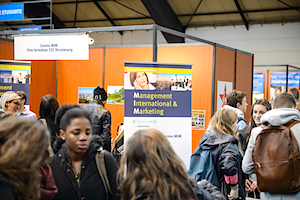8 Ways Middle Schools Can Build College/Career Readiness
Rob Messia is principal of Algonquin Middle School in the Averill Park (NY) School District.

Anyone who has ever met (or been one) knows that it’s challenging for an early adolescent to visualize what their lives will be like five or 10 or 20 years from now.
As our world changes at an exponential rate, parents and educators of those adolescents are also having trouble visualizing their future. We know, for instance, that many of the jobs today’s early adolescents will have tomorrow are still emerging – and some aren’t even on the horizon yet.
So how can we prepare middle schoolers for a future that we really can’t predict? Much lip-service is given to the concept of “career and college readiness.” It’s easy to say that our schools need to make sure every child is ready for post-secondary decision making.
What is not so easy is translating that into specific programs and actions schools can put in place to ensure all our students achieve this objective. And if those schools are middle schools, the problem is magnified. Many districts consider career and college readiness the business of high schools, where “graduation” makes the future beyond K-12 a tangible, if not measurable, event.
We know that student reading success at the elementary level, particularly reading on grade level by third grade, has a tremendous impact on an individual’s long term academic and career success.
Middle school, however, is perhaps the unspoken linchpin in establishing a positive trajectory for career and college success, and here’s why: the exploratory opportunities and soft skills developed in early adolescence bridge elementary literacy with high school level life decision-making, which will ultimately lead to graduation and post-secondary achievements.
Based on my own experience, here are eight ideas for middle schools to consider as they search for ways to promote college and career readiness effectively.
1. Set High Expectations for All: Today
One of the most powerful daily messages that teachers can give (and demonstrate) to their students is that they have high, achievable expectations for each one. Continually increasing the content and skill level expectations is something all teachers can do. This attitude can have a profound, positive impact on a school’s culture, and I would argue it begins with the principal.
Principals can make this a central component of faculty, curriculum, and team meetings and instill a sense of “we can do this” in all school community members. Motivational banners, occasional inspirational messages on morning announcements, emails about expectations to families: all help to create a culture of success.
2. Set High Expectations for All: Tomorrow
I think it’s crucial for middle schools to express the goal that every child will have a plan for their post-secondary experience. This is how we help young people create a true vision of the future. While college may not be for everyone, it’s critical that students understand that learning does not stop once they receive their high school diploma.
Rather, a message of the continuity of educational experiences, be it vocational training, community college course work, apprenticeships or military service, reinforces the importance of developing the skills now that we all need for lifelong learning.
3. Explicit College and Career Pathways Course
One of the most powerful things we have done at Algonquin Middle School over the past few years has been to adjust our Family and Consumer Science (FACS) program to emphasize the importance of college and career planning.

This includes developing individual goal setting, investigating majors and degrees, completing mock college applications, developing resumes and preparing for job interviews. Above all, this course emphasizes that planning and preparation are an integral part of a trajectory for high school and beyond.
4. High School Credits at the Middle Level
Another concrete action step that middle schools can put in place is offering more high school credits for students, particularly in Grade 8. This serves a number of purposes.
First, students will have the ability to take challenging coursework during their middle years. At Algonquin we have chosen to offer electives in various areas for which students receive high school credits. These include “Current Global Issues,” “Explorations in Music,” “Studio in Art,” and “Robotics.”
Additionally, our seventh and eighth graders take a two year high school technology course called “Design and Drawing for Production.” In combination with Languages Other Than English and acceleration offered in mathematics and Earth Science, students can have a jump start on their high school credits and will have greater time in their schedules at that level to pursue even higher level coursework, internships and other co-curricular experiences. Ultimately this leads to a more robust transcript and set of school experiences.
5. College and Career Theme Days

Additionally, all teachers take a few minutes at the beginning of their classes to talk about how they navigated their decisions around what to do after high school. These are powerful discussions, with students engaging with faculty members about their life choices and often interesting and divergent ways of getting to their ultimate career choices.
While some teachers will say they always knew what they wanted to do when they grew up, others share with students that they started in other fields and why they made those choices when they did.
6. College Admissions Visits
Working with area colleges, we are able to introduce students to expectations of college life, course work, and the admissions process. We have worked with public and private colleges, both four and two year, in these presentations which are often given by the institution’s admissions representatives. Each time our students have heard outstanding messages aimed at all learners.
We’ve also done field trips to local colleges through admissions offices to emphasize the idea that everyone can aim high and achieve great things in their pursuit of career and college goals.
Finally, based on a college admissions officer’s recommendation, we encourage families to visit colleges as early as their 8th grade year. These could be local colleges or even ones that may be located along the way to visiting family or vacation destinations.
7. Connect with High School
Middle level educators know that our work preparing students for college and career success is not finished when a student moves on from eighth grade. Facilitating a smooth transition to the high school is a critical step in establishing long term success for students. In our district this is a long standing and multi-pronged effort.

8. Provide Positive Role Models
It’s surprisingly easy to build positive connections with local colleges. These relationships provide a great opportunity for middle schoolers to interact with positive role models who are currently committed to achieving post-secondary success.
At our school this has taken a number of forms over the past several years. Each semester we are very fortunate to have Rensselaer Polytechnic Institute Engineering Ambassadors spend an entire day with our science students. They provide interactive lab-based presentations on STEM topics and then hold a town hall assembly focused on the college application process, college coursework and college life.
Prior to implementing this program, we had a long-standing relationship with Siena College where undergraduate psychology students would come into our sixth grade classes to present Emotional Quotient “EQ” lessons focused on thinking, feeling and behaving. This program accomplished several goals simultaneously, including increasing our social-emotional learning.
Finally, we also strongly encourage our faculty to host student teachers. This great opportunity, when used correctly, provides students with opportunities to interact closely with college students who aren’t too many years ahead of them in their life’s journey.
Rob Messia is the principal of Algonquin Middle School in Averill Park, New York, and a 2016 America Achieves New York Educator Voice Fellow. Before becoming principal, he was a social studies teacher. He began his work at Algonquin Middle School as a college student volunteer in the “EQ program” described in this post. When not roaming the halls at AMS, Rob enjoys spending time with his wife and two future middle schoolers.





































So many great tips for other middle school educators! Thanks for sharing, Robert.